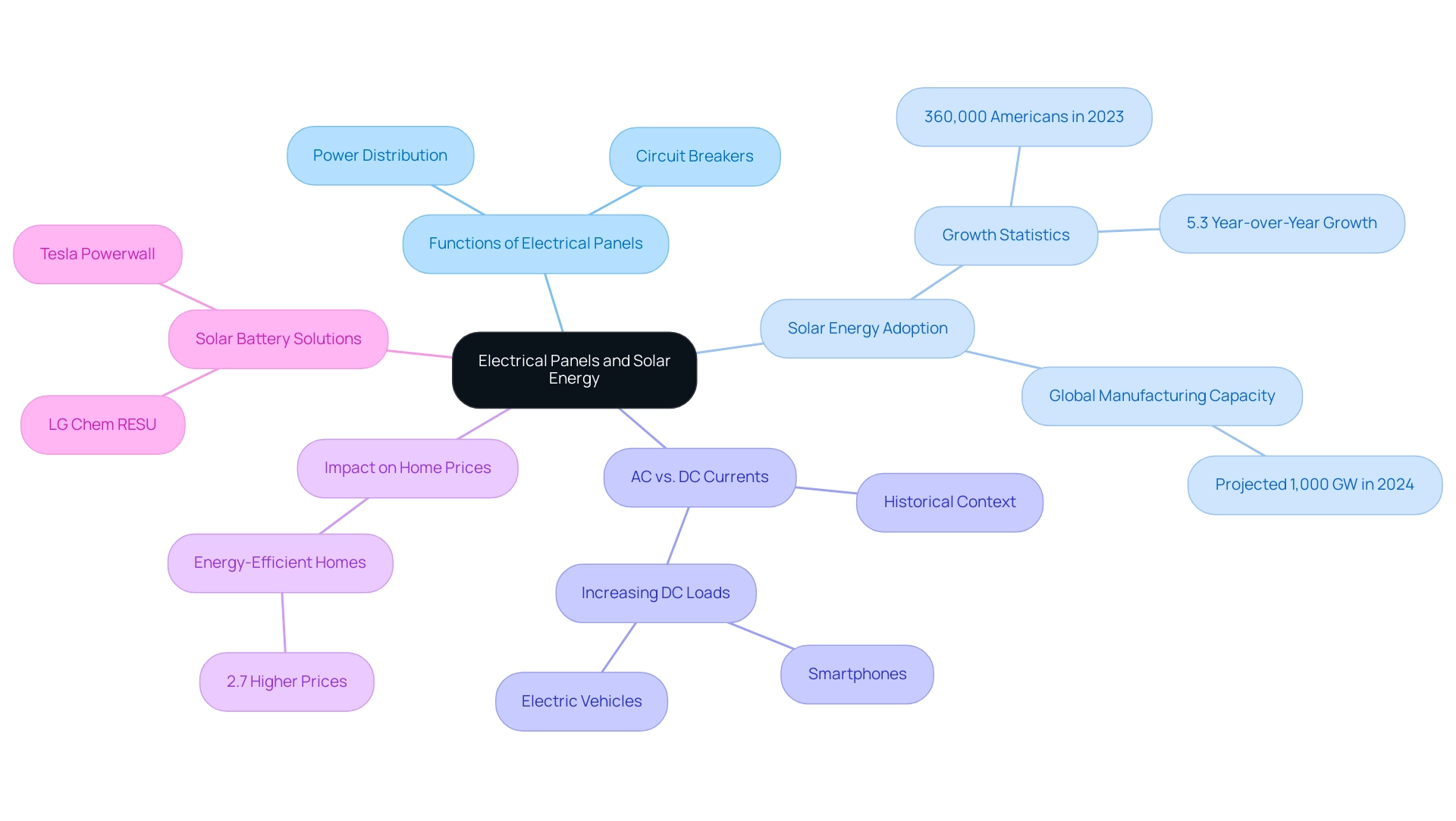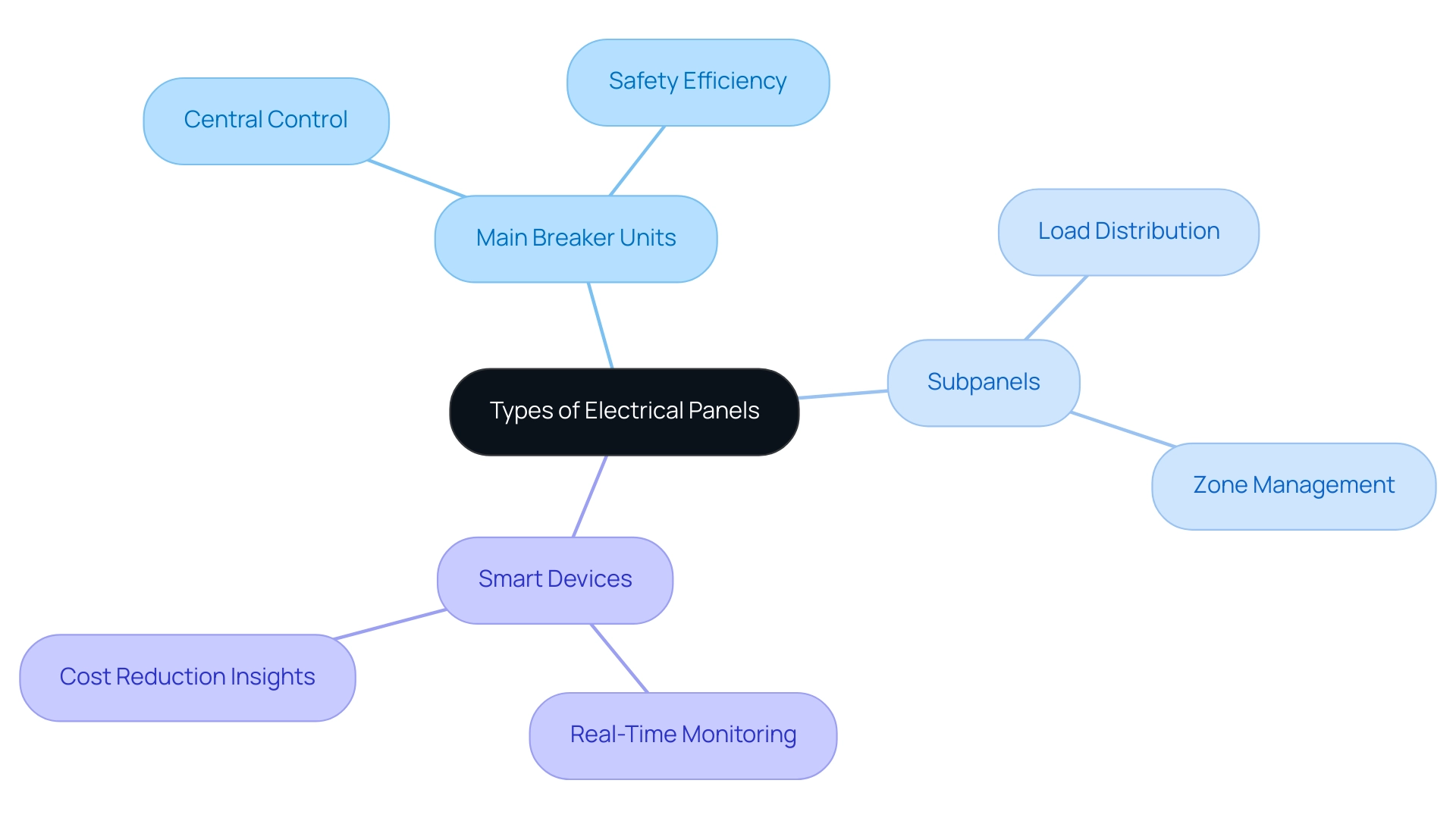Introduction
In the ever-evolving landscape of home energy management, understanding electrical panels is more crucial than ever. These essential components serve as the backbone of a home’s electrical system, distributing power safely and efficiently to every corner of the household.
With the rise of renewable energy sources like solar power, homeowners are increasingly looking to optimize their electrical setups to accommodate new technologies and improve energy efficiency.
This article delves into the fundamentals of electrical panels, exploring their:
– Types
– Installation processes
– Safety standards
– The latest innovations shaping the future of home energy management
Whether considering a solar upgrade or simply wanting to enhance energy efficiency, gaining insight into electrical panels can empower homeowners to make informed decisions that benefit both their household and the environment.
Understanding Electrical Panels: Basics and Functions
Electrical units, frequently called breaker boxes or distribution boards, are the core of your residence’s electrical system. They receive power from the utility company and distribute it across various circuits, ensuring everything operates smoothly. Within each unit, circuit breakers play a crucial role in protecting your home’s wiring by preventing overloads.
As more homeowners adopt solar power solutions, comprehending how panels for electricity operate becomes progressively essential. In 2023, over 360,000 Americans committed to solar energy, reflecting a 5.3% increase from the previous year. This change indicates that power units must now support not only traditional alternating current (AC) loads but also the increasing demand for direct current (DC) from devices such as smartphones and electric vehicles.
A recent case study on ‘AC vs. DC Current in Modern Homes’ highlights this transition, emphasizing the need for circuits to adjust accordingly. Furthermore, Freddie Mac observes that residences with efficient ratings fetch 2.7% higher prices than their ungraded equivalents, highlighting the importance of comprehending circuit boards concerning power efficiency. With global solar PV manufacturing capacity anticipated to approach nearly 1,000 GW in 2024, incorporating panels for electricity into our residences is becoming standard.
Acquainting yourself with your power system’s functions can guarantee safe and efficient resource usage, paving the way for innovative power solutions in your residence. For instance, considering solar battery options like the Tesla Powerwall or the LG Chem RESU can provide reliable power during outages and adverse weather conditions. These batteries not only store surplus power produced by your solar systems but also improve efficiency by enabling you to utilize stored power during peak demand periods.
By comprehending both your power distribution system and the top solar battery options, you can enhance your residence’s energy management by incorporating panels for electricity for improved sustainability.
Exploring Different Types of Electrical Panels
When it comes to electrical panels, you have a few key options to consider that can really impact how efficiently your home uses electricity:
-
Main Breaker Units: Commonly located in many residences, these units act as the central point for controlling your main power supply. They guarantee your residence obtains the power it requires safely and efficiently.
-
Subpanels: If you’re seeking to lessen the burden on your main unit, subpanels are an excellent option. They assist in distributing power to particular sections of your home through panels for electricity, facilitating the management of consumption in various zones, especially in larger residences or those with significant electrical requirements.
-
Smart Devices: These cutting-edge systems take things a step further by offering enhanced monitoring and management capabilities. With intelligent displays, you can monitor your energy consumption in real-time, providing you valuable insights into your usage patterns and assisting you in finding ways to reduce your electric bill.
According to recent forecasts, the power distribution market is anticipated to experience considerable revenue growth across different applications, including residential and commercial sectors, from 2019 to 2031. This trend highlights the growing demand for efficient energy solutions tailored to modern needs.
As Kalyani Raje pointed out, ‘You will be granted exclusive rights to engage with the relevant analyst for unlimited time before and after acquiring the report,’ highlighting the significance of making informed choices regarding your power distribution options.
Furthermore, a case study on the application segment analysis of electrical devices illustrates how different types of equipment are utilized across various end-use industries, highlighting their relevance in today’s market.
Each variety of module has unique features that cater to different needs, so it’s essential to assess your specific requirements before making a choice. Recognizing which option aligns best with your lifestyle can lead to improved efficiency and potential cost savings in the long run.
Step-by-Step Guide to Installing Electrical Panels
Setting up a power distribution unit may appear intimidating, but with a welcoming attitude and a straightforward guide, you can manage the procedure securely and efficiently. Here’s a straightforward step-by-step guide to help you along:
-
Turn Off Power: Always ensure the main power supply is completely turned off to avoid any risk of shock.
Safety first! -
Remove the Old Unit: If you are replacing an existing component, carefully disconnect the wires and take out the old unit—take your time with this step.
-
Install the New Unit: Securely attach the new power unit to the wall, ensuring it’s level and firmly secured.
Connect the Wires: Following the manufacturer’s instructions, connect the incoming supply wires and circuit breakers.
Consulting an energy engineer at this stage is highly recommended, as they can help you accurately estimate amperage needs before installing new appliances.
Test Connections: Once everything is connected, restore power and test the system to confirm everything is functioning as it should.
- Label Circuits: Clearly label each circuit breaker for easy identification down the line—this can save you a lot of hassle in the future.
Keep in mind that while DIY projects can be rewarding, hiring a licensed electrician is always a smart choice.
Given the current labor shortages in the trades, as noted,
the demand for skilled tradespeople has driven up wages, which can impact your overall project costs.
For a sub-panel installation, you can expect costs to range from $500 to $1,800, depending on various factors like size and labor involved. Additionally, materials such as connectors and junction boxes typically fall between $111.15 to $136.63.
Case Study: When remodeling or adding an extension, such as a mother-in-law suite, installing a sub-panel may be necessary. This example demonstrates how the overall cost is affected by the size, distance from the main breaker, and labor involved, making it typically less costly than a full-sized breaker setup. Always prioritize safety and compliance with local codes to ensure a successful installation.
Safety Standards and Compliance in Electrical Panel Installation
When it involves power distribution installation, safety must consistently be your primary concern. Here are some essential standards and compliance tips to keep your residence safe and your power system running smoothly:
- Local Codes: Before you start, take a moment to check your local building codes. They often have specific requirements for the installation of panels for electricity that you must follow.
- Permits: Don’t forget to secure any necessary permits before diving into the work. This step ensures you’re in compliance with local regulations, protecting both your home and your investment.
- Quality Materials: Using high-quality, certified materials is crucial. With about 29% of subpar devices coming from marketplace sites, it’s vital to choose products that meet safety standards. As Electrical Safety First points out,
The statistics highlight the significance of purchasing certified products and staying vigilant against counterfeit items that pose serious risks.
- Professional Help: If you’re ever in doubt, don’t hesitate to consult or hire a licensed technician. Their expertise can help ensure that all safety standards are met, providing peace of mind. Involving professionals not only adheres to safety protocols but also fosters a culture of safety, as indicated by a survey revealing that 95% of workers believe more can be done to improve workplace safety.
- Compliance Resources: To further ensure compliance, utilize available resources for searching top violations by industry and specific OSHA standards. These tools can guide you in maintaining adherence to safety regulations.
- Stay Informed: According to a 2023 survey, understanding the latest safety standards and compliance statistics is vital. Frequently informing yourself about these changes can greatly improve your safety practices.
By adhering to these guidelines, not only do you safeguard your residence, but you also enhance the reliability of your power system, which may include the installation of panels for electricity. Remember, a little extra care goes a long way in creating a safe and efficient living environment.
The Future of Electrical Panels: Innovations and Trends
The outlook for electrical systems is appearing extremely encouraging, filled with advancements that can revolutionize how we handle power in our households. Smart technology is leading the way, with panels that utilize digital circuit breakers communicating with a central data control center to monitor and manage power loads. This advancement not only simplifies resource management but also enhances overall efficiency.
As solar integration increases, particularly with solutions such as Tesla home chargers, new designs are being created that function harmoniously with solar systems, ensuring reliable power production and consumption. Furthermore, advancements in storage solutions, including the best solar battery options, enable electrical panels to effectively balance both generation and consumption. These advancements empower homeowners to take charge of their resource consumption in a way that aligns with a sustainable lifestyle.
Government programs play a crucial role in supporting homeowners in adopting these technologies, providing financial incentives and resources that make solar energy more accessible. Furthermore, maintaining the efficiency of solar systems through eco-friendly cleaning options is essential for optimal performance. Companies like Qmerit, which has completed over 86,700 electric upgrades and earned a top customer satisfaction rating, help homeowners confidently embrace smart installations.
As the President of Qmerit wisely states,
For further details, ask for a consultation today to discover more about our intelligent electric system solutions for your residence!
Embracing these technologies not only enhances efficiency but also contributes to a greener future for all. The goal of home energy management is to create an integrated system that monitors and controls energy production and consumption, further enhancing the benefits of these innovative panels.
Conclusion
Understanding electrical panels is essential for homeowners looking to enhance their energy management, especially in an era where renewable energy sources are increasingly popular. This article highlighted the fundamental roles of electrical panels, including their types and functions, the installation process, and the importance of adhering to safety standards. Each type of panel—from main breaker panels to smart panels—offers unique features that cater to diverse energy needs, making it crucial to assess individual requirements for optimal efficiency.
The installation of electrical panels, while manageable, necessitates careful attention to safety and compliance with local codes. Whether opting for a DIY approach or hiring professionals, ensuring that all steps are followed meticulously can safeguard both the home and its occupants. Furthermore, the future of electrical panels is bright, with innovative technologies transforming how energy is managed, particularly through smart technology and solar integration.
By familiarizing with electrical panels and considering the latest advancements, homeowners can make informed decisions that lead to improved energy efficiency and sustainability. In a world increasingly focused on green solutions, understanding and optimizing electrical panels not only enhances personal energy usage but also contributes positively to the environment. Embracing these changes empowers homeowners to take charge of their energy consumption while paving the way for a more sustainable future.







